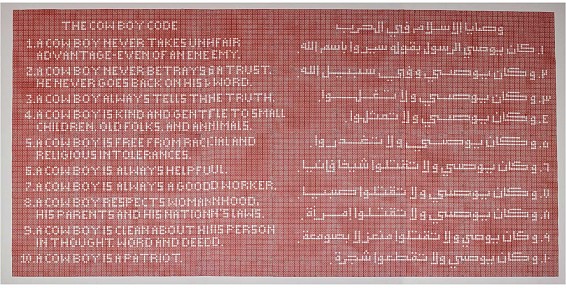MENAM At Armory 2015
March 13, 2015 - By Danna Blog
Athr Gallery (Special Projects)
Ahmed Mater
Cowboy Code (Hadith), 2012
Pier 94: Focus Lounge
Plastic Gun Caps
March 13, 2015 - By Danna Blog
Athr Gallery (Special Projects)
Ahmed Mater
Cowboy Code (Hadith), 2012
Pier 94: Focus Lounge
Plastic Gun Caps
March 7, 2015 - By Madmin for Droste Effect

March 6, 2015
Saudi artist Ahmed Mater juxtaposes value systems with this large-scale text installation in the form of a Ten Commandments script. The work is physically made up of baby gun caps, like the ones Mater played with as a child in Saudi. He and his friends would watch westerns and imitate cowboys on TV. Excerpts from the text include: “A cowboy is free from racial and religious intolerance," and “A cowboy is a Patriot." The cowboy code is directly contrasted against the Hadith, an Islamic code bequeathed by Prophet Muhammad; fragments include “He cautioned never to be extreme or fanatic."
March 6, 2015 - By Jasmine Bager
We spoke to the co-founder of Athr, who is also the vice chairman of the Saudi Art Council, Mohammed A. Hafiz. He greeted us at their booth #542, in Pier 94. Hafiz explained the significance of text and imagery in communicating across languages—English and Arabic—in the carefully curated selections on display this year. The various pieces each hint at the flexibility of text; how language can easily morph, depending on the context. Language, he said, is not limited to the spoken word; it is also based on visual references, even subtitles in a film. The chosen artists, Ayman Yossri Daydban, Mahdi Al Jeraibi, Bakr Shaykhoon and Ahmed Mater demonstrate that in different ways.

March 5, 2015
Ahmed Mater, Cowboy Code (Hadith) (2012), presented by Athr Gallery (Jeddah)
This installation compares two codes of ethics, the former from the American West and the latter from the Islamic code, referring to statements or actions of the Prophet Muhammad, known as the Hadith. The Cowboy Code (Hadith), located in the Focus Lounge on Pier 94, is composed entirely of the red plastic toy gun caps, canonical with the image of Western Cowboys and tropes of Mater’s childhood and US popular culture.
March 5, 2015 - By Kelly Crow
Over in the section for Middle Eastern galleries, Saudi Arabian artist Ahmed Mater’s 2011 work, “Cowboy Code,” was hard to miss.
Using red-plastic gunpowder caps often used for Western-style toy guns, Mr. Mater constructed a 26-foot-long mural that juxtaposed informal rules that cowboys historically lived by—such as “A cowboy never betrays a trust”—with similar, Arabic sayings from Islamic teachings like “The Prophet cautioned to always march in the name of God.” Saudi Arabian gallery Athr, which represents Mr. Mater, said the work is still available for $88,000.
The Armory, NY
Booth 631 MENA, Focus
New York City, USA
Complex systems of communication are deeply entrenched in human culture. Language, in addition to its strictly communicative uses, has many social and cultural behaviours – governing and regulating group identity, social stratification, as well as social grooming, entertainment, religious and political control. There are in this way, inherent possibilities in the relationship between language and art, particularly when considering art’s material qualities – visual, aural and beyond. The philosophy of language and its societal role has been argued since Gorgias and Plato in Ancient Greece – the question of whether its fundamental purpose is to represent experience, emotion or logical thought is a continued source of inquiry. Language – as it appears in contemporary art – questions innate properties of productivity, recursivity, and displacement.
Taking visual art's ongoing engagement – and entanglement – with language as its departure, the proposed presentation acknowledges language’s labyrinthine qualities, its endless possible permutations and considers distinctive manifestations of language in film and popular media. Within each work, language is denied its interpretive or explicatory function, narratives are outlined then refuted, nostalgic associations are savored and then curbed. The works embrace language's more permeable state: its elasticity, its penchant for questions, misinterpretation, subtexts and double meanings. Exploring language's ability to prompt empathy, the works are emotive and occasionally melancholic, collectively they embrace questions of politics, identity, idealism, and alienation. Prevailing throughout is a nagging sense of inevitability that reflects upon - and perhaps even amplifies - the uncertain future of Saudi’s and the region’s social landscape.
The artists Ayman Yossri Daydban, Mahdi Al Jeraibi, Bakr Shaykhoon and Ahmed Mater use the opportunity language affords to move freely between disciplines – exploring film, sculpture, artefact and found matter – experimenting with language, they liberate it from the page and from its systematic and descriptive duties and transport it to more mutable territories. The works selected for Armory 2015 more specifically take ‘language as artifact’ as a shared premise and approach. The pieces look towards underlying messaging, communicating to a present and future, they rely on the idiosyncratic use of language in recent history and pop culture. They address language as a remnant, residual evidence of experience and of defining cultural threads. For the works selected, the letter, the word and the phrase are seen and experienced as well as read. Language that was once common-place and used across a variety of popular media in Saudi Arabia in the 70s and 80s, when combined with symbolic objects, becomes a trigger to a retrospective understanding of collective experiences and the parameters of social conditioning within Saudi society. Through these works, each artist explores a haunting, a capturing of defining moments in their own more subjective recollections.